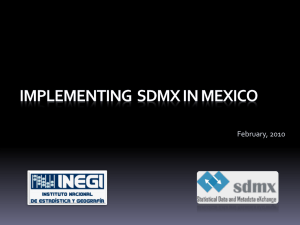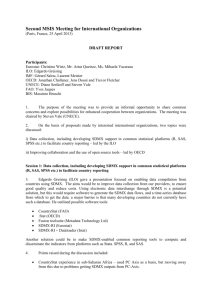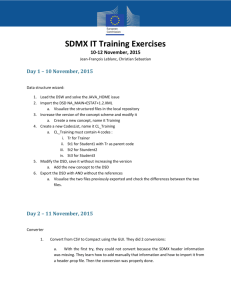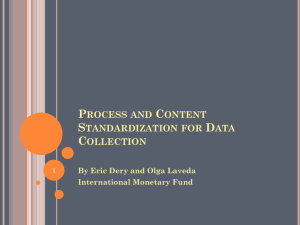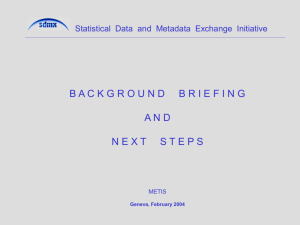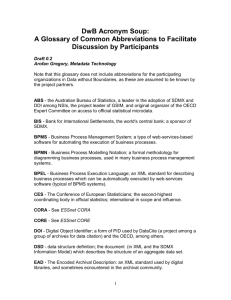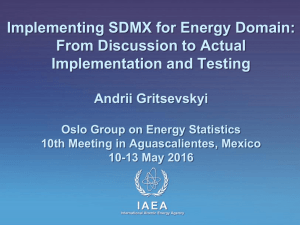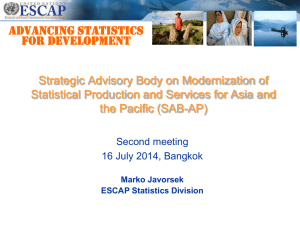MarketMap Analytic Platform & Statistical Data Exchange
advertisement
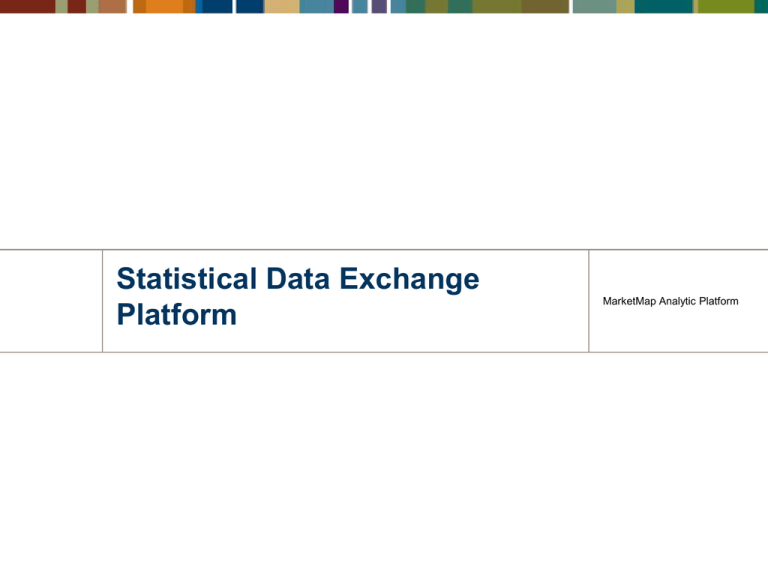
Statistical Data Exchange Platform MarketMap Analytic Platform Agenda Introduction to MarketMap Analytic Platform Sample Statistical Data Exchange Platform Economic Data Manager SDMX Driven Roadmap 2 MarketMap Analytic Platform USERS MarketMap Analytic Language C Available 3rd Party Interfaces Forecasting, Analysis & Modeling Environment Onsite Server • Fast DB for time series data storage • Built in Analytical platform • Time intelligence Web Services Web Reports APPLICATIONS Managed Data Services Data Loaders Out-of-the-box development and user interfaces SQL Access Pathfinder Cross Symbology MarketMap Analytic Platform 3 Key, Value Pair Time Series Data Storage Vector object database with coupled analytical engine Store, retrieve, and manipulate large numbers of rapidly accessible facts ‒ ibm.close ‒ sp500.TotalReturn ‒ PCT(s779255.sales) Btree Data Apply a structured programming language geared towards manipulation of vector objects 4 Analytic layer with an embedded concept of time Regular frequencies: events recorded millisecondly, daily, monthly, etc Pattern frequencies: specialized, but regular (e.g. market hrs) Aperiodic: for event-driven data capture (trades, corporate actions) Able to automatically convert frequencies GLOBAL FORMULAS Business Monthly Quarterly Return Automatic Frequency Conversions Monthly Monthly Monthly Monthly 5 Multiple Analytic Databases house all required data This MarketMap Analytic database persists historical market data objects This MarketMap Analytic database persists historical macro economic objects 6 MarketMap Economic Data Manager Extract, transform and load data stored in Excel workbooks Dual database system ‒ Time series data stored in FAME databases ‒ Meta data about these series stored in SQL container Web Access layer used to report and graph time series data and also display descriptive data about the series 7 Economic Data Collected in Excel Workbooks 8 Common "access point" to Time Series & Metadata Relational Database Client Applications Client Applications MAP Web Access Server HTTP Request Service Request Web Browser Business Process Downstream MAP Database Web Service (WSDL) HTML / CSV / XML Time IQ / Result Set Remote MAP Web Access Server Output Providers Proprietary Database 9 Statistical Data Warehouse Use Case 10 Sample statistical production process Statistics Production Environment Collect Compile Disseminate publications web ESCB-Net/EXDI Production system (FAME) SDW ESCB-net SDMX Data Model 11 11 Data structures Statistical data can be grouped together at ‒ the observation level (the measurement of some phenomenon); ‒ the series level (the measurement of some phenomenon over time, usually at regular intervals); ‒ the group level (a group of series – a well-known example being the sibling group, a set of series which are identical, except for the fact that they are measured with different frequencies); and ‒ the dataset level (made up of several groups, to cover a specific statistical domain for instance). Dimensions are grouped into keys, which allow the identification of a particular set of data (a series, for example). Key values are attached at the series level and given in a fixed sequence. Partial keys can be attached to groups. 12 12 Example: Monetary aggregate M3 BSI.M.U2.N.V.M30.X.I.U2.2300.Z01.A BSI = Key Family, M = Monthly series, U2 = euro area aggregate, N = Non-adjusted, V = MFIs + Govt, M30 = M3, X = Unspecified maturity, I = Index, U2 = residence of counterpart is euro area, 2300 = other residents sector, Z01 = denominated in all currencies, A = Annual growth/change 13 13 Use of a (SDMX-based) structured data format In the exchange, storage and dissemination of all statistical data and associated metadata In the internal system and the communication with partner institutions and the general public (web services, SDMX-ML based extractions from the web site) Covering most domains of economic statistics (e.g. monetary and financial statistics, balance of payments, price indices, short-term statistics, real sector, government finance statistics, securities, etc.) 14 14 Browsing for data series Organize object names and categories based on the SDMX standard 15 Demo: Key family search 16 Demo: Context sensitive selection boxes 17 Demo: Report on the January 2006 data 18 Demo: Detailed CPI search results 19 Demo: Select objects of interest 20 View objects in monthly frequency 21 Demo: View selected objects in annual frequency 22 Demo: Multiple ways of aggregating data 23 Demo: PCT 24 Demo: Graph selected objects 25 Demo: Administer user entitlements 26 SDMX Oriented Roadmap MarketMap Analytic Platform 27 Central Bank Use Case Using FAME since 1993 to not only store time series but also to produce statistics from primary to derived information, to disseminate statistical information, internally and on the internet, in different ways (statics, and dynamically) and formats, and, to exchange statistical information with national and international organizations using the SDMX standard. Core tools ‒ Hundreds of functions and procedures using Fame/4GL, TimeIQ and the C-HLI ‒ Working with FAME 9.3 and migrating to FAME 10.1 28 High priority database improvements Integration of FAME vectors, formulas, functions and procedures with the SDMX information model and SDMX ML format ‒ Specific objects to manage data structural definitions (DSD) information ‒ Referential integrity between series names and the DSD ‒ Creation of a matrix object to deal with observation-level attributes New second sub-index referencing the attribute so that attribute series values and their observation level attributes can be stored together Concurrent database updating ‒ Current update mechanism locks database at the database level which prevents users from updating data at the same level concurrently 29 High priority end user improvements Friendly menu-driven environment for end users & developers ‒ Take a page from SAS, eViews and others who provide a menu driven experience for building statistical studies ‒ Take a page from Eclipse or Visual Studio .NET who provide an integrated development environment complete with syntax wizards, auto completion facilities and debuggers Attribute searching facilities ‒ Wildcard searching on the information stored in attributes that perform with the same level of efficiency as the searching facilities for series name and series alias 30 Statistical Data & Metadata eXchange SDMX is not just tagging of data with XML. Its intent is to be a standard for data interrogation (SDMX Registry) and common format for publishing (SDMX XLM output) . SDMX Data – Query Response provider in Web Access ‒ Included a POC SDMX registry. ‒ The Metadata for a few Forex based times series using SDMX structures were placed in this registry by hand. The Registry was implemented in MySQL. ‒ The SDMX Custom Service provider implemented the SDMX V1.0 standard. ‒ It included SDMX supported query response. The idea here is you hit the MYSQL that has the SDMX Registry to discover what data is available at that site. ‒ Create a second call that had the SDMX Data information. That second call for the data was in SDMX xml form and the CSP received that request, looked at the SDMX Registry which had a hard mapping to the Forex time series. ‒ The response was sent back using SDMX xml V1.0 format. 31
